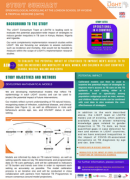
Epidemiological Modelling at LSHTM
Epidemiological Modelling at LSHTM
Gaps remain in our understanding of gender disparities in TB burden, diagnostic and treatment pathways. Whilst community-based studies maybe able to answer some research questions, questions about long-term impact, including transmission and mortality, particularly relating to the scale-up of activities, cannot be measured or addressed by such studies. Mathematical modelling and other quantitative methodologies offer a useful tool to complement community-based studies being conducted through LIGHT.
To examine long-term and broad impacts of LIGHT strategies, the LIGHT Modelling Working Group, led by LSHTM, developed country-level, deterministic compartmental models of TB epidemiology. These models are stratified by age, sex, and HIV status and are being calibrated to epidemiological and programmatic data to reflect the dynamics of TB epidemics in LIGHT partner countries. The model calibration process is an iterative one and will be conducted in close collaboration with partners from National TB Programmes to ensure consensus around model projections.
Models will then be used to simulate interventions and assess potential:
- short-term programmatic impacts (e.g., numbers of individuals screened and treated),
- long-term epidemiological impacts (e.g., incidence and mortality in men, women, and children), and
- markers of equity in disease burden and care (e.g., gender gaps in prevalence and treatment coverage).
The LIGHT modelling team has also made use of existing data sources to conduct quantitative analyses to fill additional knowledge gaps. These include:
- Preliminary analyses quantified gaps in TB disease duration across the sexes in LIGHT partner countries.
- Quantified inequalities in the impact of COVID-19-associated disruptions on TB diagnoses by age and sex in 45 high TB burden countries.
- Quantified potential transmission by age and sex on a regional and global level, to better understand the ways in which men’s excess burden of disease impacts across the population. [not yet published]
- Contributed to an updated systematic review of tuberculosis prevalence among men and women in low- and middle-income countries. [awaiting publication]
- Examining social and structural determinants of sex differences in tuberculosis prevalence across high burden settings, to better understand the drivers of these disparities. [not yet published]
Impact
Calibrated models can then be used to examine the potential impact of strategies to improve men’s access to TB care on the TB epidemic in each setting, either at a population level or specifically among population subgroups such as men, women, and children. Model results can be combined with cost data to also evaluate the cost-effectiveness of strategies.
For more information, please contact Dr Katherine Horton at katherine.horton@lsthm.ac.uk.
Click on the image below to download LSHTM study summary.

